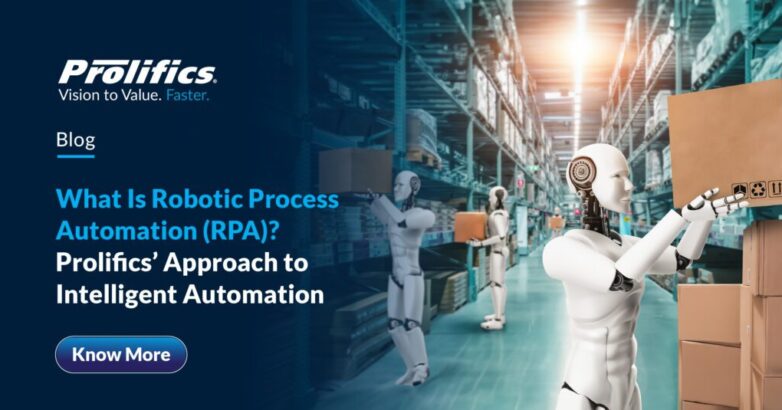Prolifics’ Approach to Intelligent Automation
In today’s competitive landscape, businesses constantly seek innovative ways to reduce costs, enhance productivity, and accelerate digital transformation. Robotic Process Automation (RPA) has emerged as a powerful tool to streamline repetitive, rule-based tasks, freeing employees to focus on high-value, strategic work. When RPA is combined with artificial intelligence (AI) and intelligent workflows, it evolves into Intelligent Automation, redefining what operational excellence looks like.
What is Robotic Process Automation and How Does It Work?
Robotic Process Automation (RPA), often referred to as software robotics, uses AI-powered automation technologies to perform repetitive office tasks traditionally handled by humans. These include data extraction, form filling, file transfers, and triggering workflows across systems like CRMs and ERPs, without requiring API-level integration.
What sets RPA apart is its use of GUI-level automation. This means bots can simulate human interactions, such as mouse clicks and keyboard inputs, across software applications.
Common processes automated by RPA:
- Data extraction and transformation
- Invoice and payment processing
- Report generation and email notifications
- System-to-system communication
This functionality lays the foundation for end-to-end process automation across enterprises.
RPA and Intelligent Automation
Intelligent Automation (IA), also known as Intelligent Process Automation, takes RPA to the next level. It integrates RPA with AI technologies, business process management (BPM), Business Process Automation (BPA), and analytics to deliver smarter, end-to-end automation.
Key enhancements include:
- Natural Language Processing (NLP) for interpreting unstructured data
- Machine Learning (ML) to adapt and improve over time
- AI-based decision-making to handle exceptions and anomalies
This holistic approach enables businesses to automate not just tasks, but entire workflows with intelligence and flexibility. It also addresses the growing need for hyperautomation strategies in enterprise environments.
RPA and Artificial Intelligence
RPA and AI form a powerful partnership. While RPA excels at automating deterministic, rules-based tasks, AI introduces cognitive capabilities like vision, language processing, and predictive analytics.
When combined, AI-enhanced RPA can:
- Extract insights from unstructured documents
- Predict and resolve exceptions
- Make autonomous decisions based on learned patterns
This synergy powers the shift toward hyperautomation, a strategy that enables end-to-end process automation at scale.
How to Implement RPA in Finance and Banking
Implementing RPA involves several key steps:
- Process Identification: Identify rule-based, repetitive, and high-volume workflows ideal for automation.
- Bot Development: Use platforms like UiPath, Automation Anywhere, or Prolifics’ custom frameworks to build automation scripts.
- Training & Deployment: Configure bots via screen recording or workflow modeling; thoroughly test for accuracy.
- Execution: Bots log into applications, execute tasks, handle exceptions, and record metrics.
- Scale & Monitor: Bots operate independently, can be scheduled, and are monitored centrally to ensure performance and compliance.
Unlike traditional automation, RPA requires minimal system modifications, making it ideal for working across legacy systems—especially in sectors like finance and banking.
Benefits of AI and RPA for Enterprise Automation
- Cost Efficiency: RPA delivers fast ROI by reducing operational costs and manual errors.
- Scalability: Deploy additional bots easily to meet rising business demands.
- Accuracy & Compliance: Bots follow rules precisely, ensuring higher accuracy and auditability.
- Employee Empowerment: Teams can shift focus from mundane tasks to innovation and strategy.
- 24/7 Productivity: RPA operates around the clock, increasing speed and throughput.
These benefits show exactly how RPA improves operational efficiency across departments.
Challenges of Robotic Process Automation Adoption
Despite its many advantages, RPA implementation comes with its own set of challenges:
- Process Design Complexity: Mapping processes for automation requires precision and foresight.
- Change Management: Regular system updates may require bot reconfiguration.
- Maintenance & Monitoring: GUI changes in applications can disrupt bot performance.
- Workforce Transition: Successful RPA adoption requires reskilling and cultural alignment.
These are common challenges of RPA adoption that organizations must manage strategically.
RPA Use Cases Across Industries
Banking & Finance
- Account reconciliation, loan processing, KYC verifications
- Success Story: Prolifics helped a fintech client save over $750K annually using RPA and Intelligent Document Processing (IDP)
Healthcare
- Claims processing, patient data entry, regulatory compliance
Energy & Utilities
- Legacy system automation, centralized data workflows, predictive maintenance
Retail & Supply Chain
- Order processing, inventory management, demand forecasting
HR & Onboarding
- Automating employee enrollment and onboarding with digital assistants like Prolifics’ bot “Leia”
These are just a few examples of intelligent automation in different industries.
Prolifics’ RPA and Intelligent Automation Approach
Prolifics delivers a full suite of RPA and Intelligent Automation services:
1. Business Process Automation & RPA
- Development of simple bots and complex AI-integrated workflows
- Integration of IDP, OCR, and conversational AI
2. Intelligent Automation (IA)
- Comprehensive end-to-end process automation with BPM and analytics
3. AI-Powered Automation & Agentic AI
- Use of reasoning agents powered by IBM WatsonX, Salesforce Einstein, and Microsoft Copilot
4. Hyperautomation Strategy
- Seamless orchestration of RPA, AI, low-code platforms, and analytics for enterprise-scale automation
5. Industry-Focused Expertise
- Proven solutions across finance, healthcare, retail, energy, and manufacturing
6. Outcome-Driven Delivery
- Rapid, agile implementations with:
- Fast POCs (3–4 weeks)
- ROI-focused automation plans
- Scalable deployments
This clearly shows how Prolifics uses RPA and AI for business transformation.
Why Partner with Prolifics?
- Proven Experience: 45+ years in digital transformation and automation success
- End-to-End Solutions: From RPA to hyperautomation, all under one roof
- Deep Industry Insight: Trusted by Fortune 1000 clients across sectors
- Agile & Scalable Delivery: Rapid innovation backed by measurable business value
Conclusion
RPA is revolutionizing how organizations handle repetitive work, enabling them to operate faster, leaner, and smarter. But true transformation lies in understanding what is robotic process automation and how does it work, and moving beyond basic task automation to strategic, enterprise-wide impact.
Prolifics stands at the forefront of this journey offering a future-ready approach that blends RPA, AI, and process intelligence to deliver impactful, scalable solutions. Our experts guide you through how RPA improves operational efficiency and overcome the challenges of robotic process automation adoption with industry-tested strategies.
If you’re ready to elevate your operations, discover how Prolifics uses RPA and AI for business transformation and explore real-world use cases of RPA across finance, healthcare, and retail.




